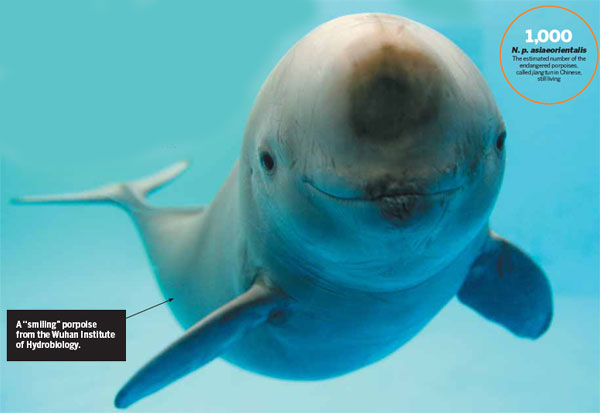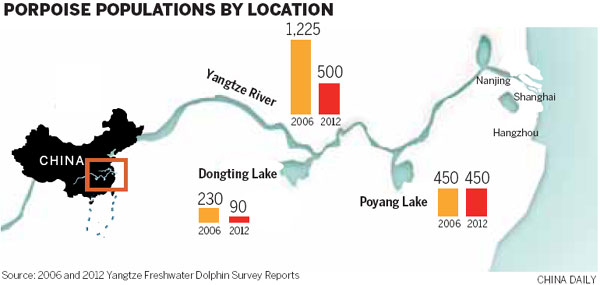Reviving the 'river pig'
Updated: 2013-12-22 07:41
By Deng Zhangyu(China Daily)
|
|||||||||
Reserves offer perhaps the best chance to save China's critically endangered finless porpoise subspecies, whose nickname comes from the fact they were once as common as swine. Deng Zhangyu reports.
Jiaojiao is free from the fishing net that injured her. She's free from the trauma of her 6-month-old calf's death in that net. And she has ultimately been freed from the captivity that followed her ordeal, after which she was too depressed to eat for a month. While Jiaojiao lost her calf and was separated from her mate this September, her neighbors at the Tian'ezhou oxbow natural reserve in Shishou, Hubei province, are a couple expecting offspring next April.
The rare pregnancy of the critically endangered Chinese subspecies N. p. asiaeorientalis, called jiangtun in Chinese, has shut down 21 kilometers of the Yangtze River's oxbow within the reserve from the public. Wang Chaoqun, a preservation expert at the reserve, regularly examines the rare mammals' health, especially the mother-to-be's.
The reserve's estimated 37 porpoises are among the fewer than 1,000 alive, a survey by scientists from China and the World Wildlife Fund found last year.
Their numbers have continued plummeting for decades. There were about 800 more in 2006.
The creatures are colloquially called "river pigs" because they used to be as ubiquitous as swine. The porpoises known for their "smiling" visages were declared critically endangered this year.
"If we don't act in the coming five to 10 years, these animals will vanish," Wuhan Institute of Hydrobiology finless porpoise expert Wang Ding says.
He believes the solution is more natural reserves like the Tian'ezhou oxbow's.
The wetland surrounding the river bend branching from the Yangtze became a protection zone in 1992.
The expecting couple was moved there after the 2008 blizzard disaster froze the Yangtze elsewhere in Hubei.
"We get three or four calves a year," Wang Chaoqun says. "We're trying to increase birth rates through captive breeding."
But the pregnancy of E'e is unique in that, while she isn't captive, her mate Tiantian was introduced by human intervention.
While the Tian'ezhou oxbow is intended as a haven from shipping, overfishing, pollution and dredging, human activities still disrupt the porpoises' habitats.
Farmers in surrounding villages joined together in 2011 to pump water from the reserve to irrigate their rice paddies when drought lowered the river.
"It's a Catch-22," says Cheng Xianhong, who has worked as a reserve administrator since 2008.
"Farmers need water for their fields. Porpoises need water to live."
Conflict erupted between farmers and the reserve. Finally, the local government pumped water into the oxbow from the Yangtze's main watercourse.
Still, despite water diversions and land grabs, the reserve remains a far better sanctuary than the polluted water elsewhere.
Gao Baoyan, a conservationist who has devoted herself to protecting porpoises for more than 10 years, says most of the dead specimens found in the Yangtze River starved.
Several jiangtun have quickly expired after becoming stranded on the shoals in recent years.
"The autopsies showed their stomachs were empty," Gao says.
Many porpoises' fins are infected by bacterial pollution, rendering them deformed lumps, Gao adds.
She agrees new reserves offer the only hope.
Wang Ding, the ecologist, is working with colleagues at the Wuhan Institute of Hydrobiology to find other suitable reserve locations in Hubei.
Wang Ding believes the Yangtze's economic importance makes it too difficult to entirely transform.
About 40 percent of China's GDP comes from cities along the river that also contain about 40 percent of the country's population.

"If measures aren't taken quickly, the river porpoise will share the fate of its cousin, the baiqi (white-flag) dolphin," Wang Ding says.
The last known baiqi died in Hubei's provincial capital Wuhan in 2002. The species is functionally extinct. That means individuals may exist but not enough to sustain the species.
The finless porpoise is like the baiqi dolphin in that it's atop the Yangtze's food chain. That makes it an environmental barometer.
"If the finless porpoises disappear, that signals the collapse of the river's ecosystem," Wang Ding says.
"And that's a warning bell for humankind."
Liu Kun contributed to this story.


(China Daily 12/22/2013 page1)